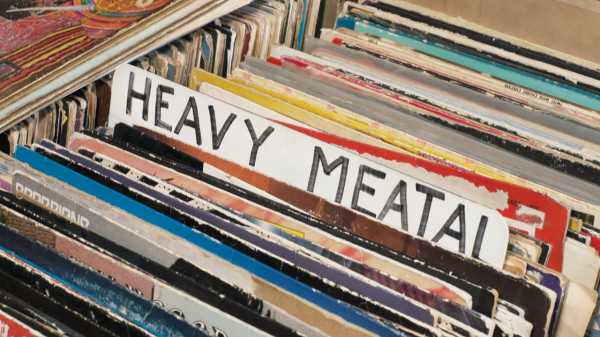
Earlier this year, the critic and historian Ted Gioia published an essay called “Is Old Music Killing New Music?” At first, this looks like a textbook case of Betteridge’s law, which states that “any headline which ends in a question mark can be answered by the word ‘no.’ ” Nevertheless, old music’s encroachment on the cultural space once occupied by new music has become difficult to ignore. Gioia marshals compelling evidence: from a music-industry analytics firm that found that old songs represented seventy per cent of the U.S. music market in 2021 to recent bidding wars over song catalogues by artists who are now septuagenarians, octogenarians, or dead.
Some of us will hear this trend reflected in our listening habits. My own musical life in this decade offers an extreme example, dominated by the likes of the Beatles, the Beach Boys, the Rolling Stones, and Bob Dylan. This resoundingly un-idiosyncratic list is the result not of an ossified musical incuriosity but of a deliberately undertaken project: whereas Gioia listens to two or three hours of new music every day, I’ve made a daily habit of listening to “old” music—music by artists who began their careers in the nineteen-sixties and have made the largest, most obvious marks on popular culture. Working my way through their entire studio discographies, I take one album per week and play it once every day, straight through. This method (which I used most recently to navigate the nearly half-century-long catalogue of David Bowie) requires both an obsessive streak and a certain degree of patience: the studio albums of Dylan alone, which number thirty-nine as of this writing, took up most of a year.
Just by chance, Dylan’s “Christmas in the Heart” happened to fall in mid-December, which enriched the experience of that spirited if bewildering holiday album. (For me, it will never again feel like Christmas without hearing Dylan croak “Adeste Fideles” in his surreal Latin.) Every discography adds another chronological-cultural layer atop the ordinary passage of time: the year 2020 yielded nobody’s idea of an ideal summer, but for me it was at least enlivened by earlier Beach Boys releases, from the 1964 hit “All Summer Long” and the 1966 critical-consensus masterpiece “Pet Sounds” to the 1973 ambitious conclusion to the band’s long heyday, “Holland.”
The reason I began this discographies project was to address the embarrassing condition of having reached the age of thirty-five without having really listened to the Beatles. Their music’s very unavoidability had kept me from engaging with it: the world, so it seemed to me, hardly needed another Beatles enthusiast. A friend suggested that I fix the hole, as it were, by listening to the Beatles’ collected work while reading Ian MacDonald’s “Revolution in the Head: The Beatles’ Records and the Sixties.” The book—an examination of every single one of the Beatles’ recordings, some of whose entries constitute short essays in themselves—also makes the case for the band’s œuvre as the unsurpassably vibrant sonic record of Western civilization’s collapse.
“Anyone unlucky enough not to have been aged between 14 and 30 during 1966-7 will never know the excitement of those years in popular culture,” MacDonald, who was born in 1948, writes. When “Revolver” came out at the beginning of that stretch, “the album’s aural invention was so masterful that it seemed to Western youth that the Beatles knew—that they had the key to current events and were somehow orchestrating them through their records.” With that release, the band arguably invented the form of the album as we know it, an artistic innovation, MacDonald explains, that was enabled by novel studio technologies: “Using the overdub facilities of multitrack recording, they evolved a new way of making records in which preplanned polyphony was replaced by an unpredictable layering of simultaneous sound-information, transformed by signal-distortion and further modified during the processes of mixing and editing.” Committing a song to tape became merely the first stage of an elaborate and unpredictable artistic process.
In MacDonald’s view, technology made possible not just “Revolver” but also the socioeconomic context for the whole explosion of exhilarating, forward-looking creativity associated with the mid-to-late nineteen-sixties. In the run-up to that era, he writes, “socially liberating post-war affluence conspired with a cocktail of scientific innovations too potent to resist,” from widely affordable cars and televisions to LSD and the pill. “For ordinary people—the true movers and shakers of the Sixties—these factors produced a restless sense of urgency headily combined with unprecedented opportunities for individual freedom.” The spirit of that decade “disseminated itself across generations, suffusing the Western world with a sense of rejuvenating freedom comparable to the joy of being let out of school early on a sunny afternoon.”
Because I was born fourteen years after the Beatles’ official breakup, in 1970, I can’t tap into the initial, primal excitement of Beatlemania. Still, the twenty-first century has advantages of its own, including our ability to listen to virtually anything we like, whenever we like. “The musical past is accessible to an unprecedentedly inundating degree,” the critic Simon Reynolds writes in “Retromania: Pop Culture’s Addiction to Its Own Past.” “All the sound and imagery and information that used to cost money and physical effort to obtain is available for free, just a few key and mouse clicks away.” Reynolds’s book came out in 2011, and the march of digital progress in the years since has only drawn us deeper into the streaming era, in which “distance and delay have been eroded to nearly nothing.”
Now that music flows “like water,” Spotify in particular has become something like a utility. Not only does the service make it easy to listen to entire discographies, its overwhelming abundance of music practically necessitates such a rigorous practice. That abundance is one vector of the boredom that Reynolds diagnoses as particular to cultural life in the twenty-first century, which furnishes us with “a thousand TV channels, the bounty of Netflix, countless net radio stations, innumerable unlistened-to albums, unwatched DVDs and unread books, the maze-like anarchive of YouTube. Today’s boredom is not hungry, a response to deprivation; it is a loss of cultural appetite, in response to the surfeit of claims on your attention and time.” To listen through the work of one artist, never skipping an album, is to (as Reynolds writes of a music-journalist friend who restricted himself to downloading and listening to one MP3 at a time) build “a filter, or perhaps a dam, to protect against the rising sea levels of the ocean of sound.”


Starting with the Beatles seemed the obvious choice. “Agreement on them is all but universal,” MacDonald writes. “They were far and away the best-ever pop group and their music enriched the lives of millions.” Their enormous influence on popular music is equalled if not exceeded by their influence on popular culture in general, a factor I’ve used to pick future discographies. (ABBA, Stevie Wonder, Joni Mitchell, and Prince are on deck.) The Beach Boys may not quite rank alongside the Beatles in that regard, but the two bands’ high-profile one-upmanship in the mid-sixties—in the annals of rock history, “Rubber Soul” begat “Pet Sounds,” and “Pet Sounds” begat “Sgt. Pepper’s Lonely Hearts Club Band”—greatly expanded the artistic possibilities (not to say pretensions) of the pop album.
Around the same time, the media also strained to generate the impression of a rivalry, which has since been exposed as practically nonexistent, between the Beatles and their countrymen the Rolling Stones. Yet the Stones did once attempt to play the Beatles’ game, as evidenced by “Their Satanic Majesties Request.” Released roughly seven months after “Sgt. Pepper,” that chaotically recorded, psychedelia-drenched, lenticular-covered album features such un-Stones-like instrumentation as a theremin, a Mellotron (an unreliable tape-based proto-synthesizer also heard on “Strawberry Fields Forever”), and a string section. On some level an abject Beatles imitation, “Satanic Majesties” has, during the past half century, undergone a more positive critical reëvaluation. It’s also remained, for me, the most memorable album in the Stones’ catalogue, more so than the straightforwardly acclaimed “Beggars Banquet” or “Exile on Main St.”
I feel similarly about the self-titled comeback album that the Beach Boys put out in the mid-nineteen-eighties, overseen by the Culture Club producer Steve Levine, which I now find myself playing more often than “Pet Sounds.” Not everyone sees the value in listening through discographies, entailing as it does prolonged exposure to just such “bad” albums as these. But the context of the full body of work also redeems them, casting each one as a chapter in the story of the artist’s own development through history (for better or for worse), and also an unaltered snapshot of its particular pop-musical Zeitgeist. Though not representative of the Stones’ larger musical enterprise, “Satanic Majesties” is representative of what was going on in 1967; by the same token, “The Beach Boys” offers a distillation of the synthesized, sequenced, and sampled sounds of 1985, all the stronger in contrast to the vocal harmonies familiar from twenty years before.
The stylistic differences between these albums and their predecessors primarily reflect changes in technology: technology used by music’s creators, as well as by its consumers. After hearing a few decades-spanning bodies of work, one gains a certain prescience about when the multitrack recorders, tape loops, gated reverb, drum machines, or Yamaha DX7 will first appear. One can also, at the same time, hear the rise and fall of the twelve-inch vinyl LP as the public’s medium of choice. The Beatles’ first early albums are simply collections of songs, most of them ready for AM-radio airplay, but, from “Rubber Soul” onward, the whole, not the parts, becomes the primary unit of musical experience. By 1968, their self-titled “White Album” is able to be as much of a cultural touchstone as any film released that year, justifying its length of ninety-three minutes.
In the following decade, Reynolds writes, “major labels operated in a manner similar to the studio system during Hollywood’s golden era: big-budget investment in potential blockbusters, resulting in expensive-sounding records made using crème-de-la-crème session musicians and top-dollar studios.” The acme of this trend was surely Steely Dan, over whose work I obsessed when everyone else must have been getting up to speed on the Beatles. Even when crafted by less perfectionistic bands, albums became lavish, practically cinematic experiences, but these ambitions subsequently fell off, in the same period that the VCR brought actual movies into the home. Far from putting an end to theatrical filmgoing, viewable-on-demand videotapes made a more aggressive claim on the sustained attention once paid to music. Then came more competition from cable television—the delivery system of the music video—and later the Internet, which completed the dismantling of the album begun by the random-access programmability of the compact disk.
In theory, these developments have been boons to consumer choice. But they’ve also aggravated what Reynolds calls “the porno-logic of franticity” that keeps us compulsively clicking (or swiping) to “the next, the next, the next,” increasingly isolated in our own algorithmically defined cultural spheres. MacDonald, who died in 2003, saw the larger trends that would bring us to this point: “Once the obsolete Christian compact of the Fifties had broken down, there was nothing—apart from, in the last resort, money—holding Western civilisation together,” and the subsequent consumer boom “speeded the melt-down of communality by allowing people to function in a private world, segregated from each other by TVs, telephones, hi-fi systems, washing-machines, and home cookers.” But the West (and much of the East, where I now live) does retain a common culture, of sorts, in the music of mass-media-age artists like the Beatles, the Beach Boys, the Rolling Stones, and Bob Dylan, all now unlikely to be surpassed in length or breadth of popularity.
Technology has reduced the formerly expensive and inconvenient task of listening through the discographies of such artists, however prolific they may be, to a matter of will and commitment—qualities now in short supply, though perhaps only somewhat less abundant than they were before the onrush of the sixties. “In societies with fewer opportunities for amusement,” W. H. Auden wrote in an essay more than half a century ago, one could more easily distinguish “a mere wish from a real desire. If, in order to hear some music, a man has to wait for six months and then walk twenty miles, it is easy to tell whether the words, ‘I should like to hear some music,’ mean what they appear to mean, or merely, ‘At this moment I should like to forget myself.’ ” Now that the distinction between the two has all but vanished, listeners hoping to remember themselves—as well as their time, place, and context in cultural history—have to stick to a strategy. ♦
Sourse: newyorker.com






